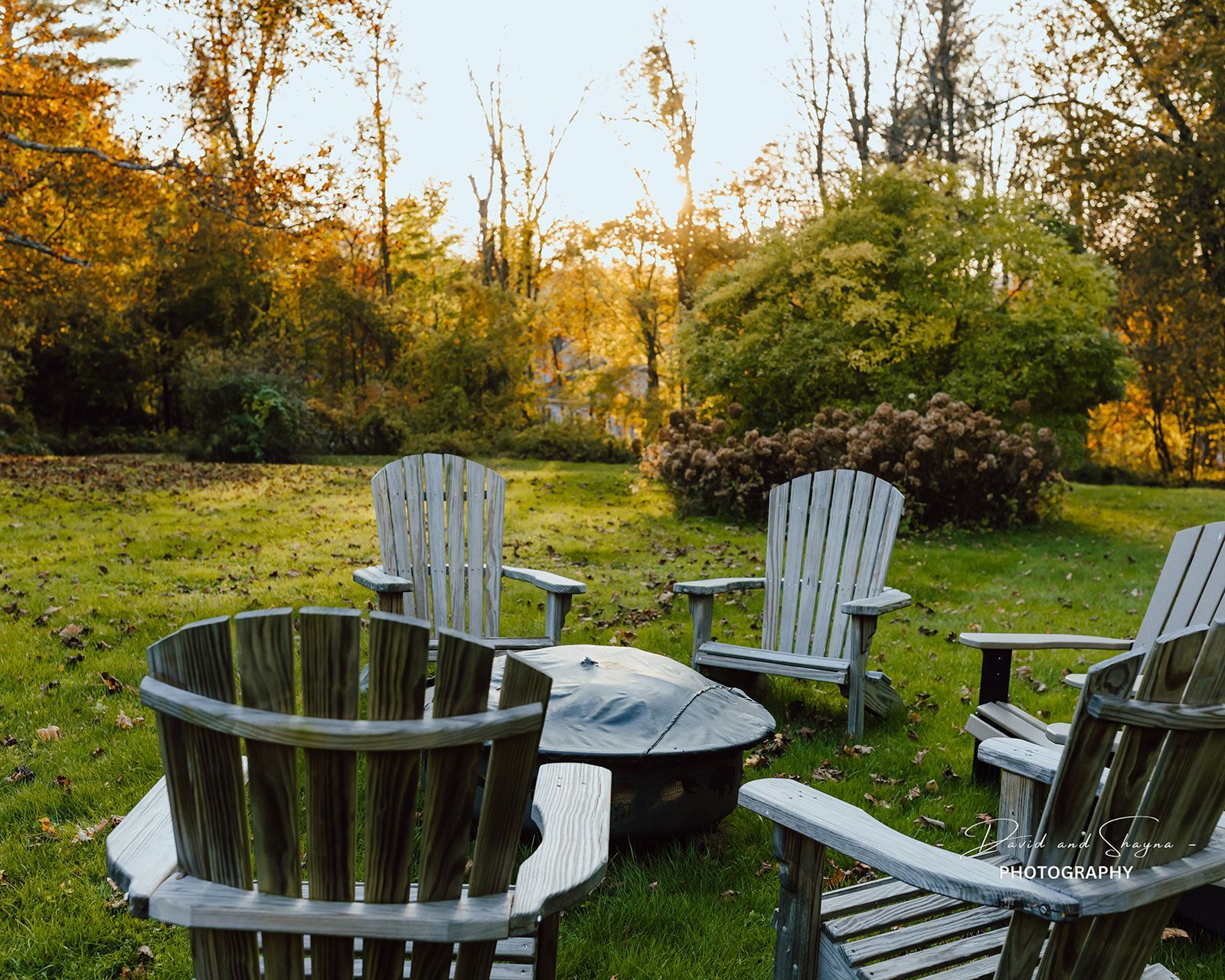The Art of Reflection: Grounding Ourselves in Connecticut's Litchfield Hills
A contemplation on place, presence, and the profound restoration that comes from stepping into landscapes that connect us to ourselves, one another, and the beauty all around

There's something that shifts when we step away from the relentless hum of our modern culture and into places where time moves differently. The rolling hills of northwestern Connecticut hold such quiet wisdom, inviting us into a deeper conversation with the natural world and historic villages that beckon us to presence, reflection, and communion.
In an age where “wellness” has become commodified, lesser-known pockets of the Litchfield Hills offer something far simpler and more substantial to support eudaimonic wellbeing: a sense of rootedness that comes from connecting with the earth and the communities that are deeply steeped in New England history; reorienting our perspective to align with long-held values. Here, in Norfolk, we cherish our community, where culture and conservation are both revered; where natural and human-made beauty are savored and celebrated.
The Sacred Ordinary: Manor House Inn as Sanctuary
The Manor House Inn in Norfolk is more than accommodation. It's a threshold space, a place where both the landscape and architecture invite transformation. Built in 1898 as the Alders Estate, this Tudor sanctuary sits on five acres that have witnessed more than a century of residents and visitors finding refuge in its embrace.
What strikes visitors first isn't necessarily the understated elegance of the spaces or the gourmet breakfasts, though these are designed to nourish and delight the senses. It's the intentionality woven into every detail; the way our innkeeping team curates not just a hospitality experience but offers a genuine welcome and an invitation to linger long enough to appreciate the simple beauty all around.
The bowl of homemade caramels at the entry is not just a small ritual of sweetness, but a reminder that care can be made tangible in the smallest and simplest of gestures. The peaceful piano music isn’t peripheral to experience, but curated to calm the body and ease the mind. The calligraphy set in the library invites thoughtful, unhurried, expressive communication – harkening back to simpler, gentler times. Space and time seem to operate differently here.
The practice of presence is built into the very foundation: uniquely furnished guest rooms and common areas where digital distancing isn't enforced but invited, where the absence of televisions creates space for the kind of conversations we often neglect to have in our everyday lives, where unstructured time invites reflection. The whirlpool tubs and wood-burning fireplaces aren't luxury for luxury's sake; they are invitations to slow down, to inhabit our bodies differently, to remember that we are more than our productivity.
In the dining room, the Tiffany windows catch the light, animating spaces with a subtle glow that shifts throughout the day. Mealtimes become an opportunity to connect, not just with Connecticut's local bounty, but with one another in conversation. The pain perdu topped with fresh fruit compote at breakfast isn't just food; it's a reflection of abundance — on the sweetness that emerges when we take the time to truly savor. The resident hummingbirds, chipmunks, foxes, and fawns just outside the window challenge us to remember how closely connected to nature we actually are, and to consider our role in protecting the delicate ecosystems of Connecticut’s northwest corner.
The Living Laboratory: Great Mountain Forest as Sacred Ground
Just minutes from this respite of human hospitality lies another kind of sanctuary entirely – the 6,000-acre Great Mountain Forest, where the beauty of the forest inspires awe and appreciation. This is more than a preserve. It's a working forest that embodies what it means to tend the earth with reverence and wisdom.
Great Mountain Forest's mission is to be a leader in forest stewardship, practicing sustainable forest management while promoting biodiversity and resilience to climate change. Here, the invitation to well-being reveals itself most clearly in the quality of awareness we bring to each step along the way. The trails are a testimony to the community’s commitment to conservation, where 6,000 acres of contiguous forest and woodland habitat support resident populations of wild turkey, white-tailed deer, coyote, black bear, and moose.
The Iron Trail to Stone Man Mountain invites a walking meditation on interconnectedness. The journey through mixed hardwood and coniferous forest offers glimpses of the forest's research mission, where scientists study everything from tree decay rates to bear and moose populations, reminding us that observation and stewardship go hand in hand.
The network of 13 miles of forest roads invites exploration through landscapes where hiking, mountain biking, cross-country skiing, and snowshoeing become forms of moving meditation. These pathways wind through working research sites where, among other initiatives, the American chestnut plantation project unfolds – a decades-long commitment to healing what seemed irreversibly damaged, teaching us about hope made manifest through patient, persistent action.
The forest serves as subject, focal point, and source of inspiration for many painters, photographers, writers, and musicians, reminding us that beauty and utility need not be separate pursuits. In the sugar house during maple season, where Great Mountain Forest taps its sugar maples and boils down the sap to produce syrup, we witness the ancient art of receiving the forest's gifts with gratitude and restraint.
The Village & Woodland Connection
The short walk between the Manor House and the Village center isn't measured only in steps but in the awareness that comes from moving through spaces that have been tended and treasured across generations. The historic architecture, parklands, and Village layout are in harmony with the natural topography; a terrain that shapes consciousness as much as consciousness shapes terrain.
In Norfolk, we appreciate the intimacy and intention of the village scale, where the walk from Manor House Inn to Infinity Music Hall reminds us that culture and nature aren't opposites but dance partners. The Norfolk Chamber Music Festival, the Yale Summer School of Music – these aren't merely entertainment but collective practices of beauty-making, reminders that humans at their best create a culture of harmony rather than discord.
The trails outside the village, including those at Haystack Mountain, Campbell Falls, and Dennis Hill, aren't just recreational opportunities but pathways of reflection; each offering its own form of elevation, both literal and metaphorical.
At Haystack Mountain State Park, the climb to the 34-foot stone tower offers a meditation on perspective. From this vantage point, seeing across Connecticut, New York, and Massachusetts, we're reminded that our daily concerns, while real, exist within much larger contexts. The tower, one of eight hikeable observation points across Connecticut, stands as a testament to the human desire to see further, to gain perspective that can only come from stepping outside our usual frames of reference.
Campbell Falls offers different medicine entirely. Here, with towering trees, birdsong, and the sound of falling water, we encounter the quality of presence that transforms ordinary moments into something special. The natural amphitheater created by moss-covered boulders and mountain laurel becomes a space where listening isn't passive but transformative.
Dennis Hill State Park features an accessible road that culminates in panoramic vistas stretching toward the Berkshires. The hills' open meadows and mixed forests change dramatically with the seasons, from spring wildflowers to the blazing autumn colors that make this a favorite destination for artists, photographers, and philosophers seeking spaces for inspiration and quiet contemplation.
The Seasons of Flourishing: When to Practice Presence
Each season in the Litchfield Hills offers its own curriculum in wellbeing:
Spring arrives as resurrection made visible – wildflowers at Great Mountain Forest, rushing waters at Campbell Falls, the tender green that speaks of life's irrepressible impulse toward renewal. This is the season for beginning again, for allowing ourselves to be surprised by growth.
Summer extends the invitation to fullness – long days that encourage deep exploration, festivals that celebrate human creativity, the abundance that comes when we align with natural rhythms rather than fight them.
Autumn teaches us about beauty in transition, about letting go as a form of grace. The legendary fall foliage becomes a master class in impermanence – showing us that endings can be the most beautiful part of any story.
Winter offers the gift of contemplation, the deep rest that makes renewal possible. By the fires of Manor House Inn, in the quiet of snow-muffled trails, we remember that dormancy isn't emptiness but preparation.
The Economics of Enough
Planning a journey to the Litchfield Hills becomes its own practice in intentionality. This isn't about frenetic activity and consumption-driven travel for “Instagrammable” moments, but about slowing down and savoring spaces that allow transformation. It’s about engaging with time and space in a different way. It's about communion and connection with the people, places, and things that awaken in us what matters most. Our challenge to guests is:
- Choose presence over productivity: Real restoration doesn't happen on the timeline of a weekend getaway but in the spaciousness that comes from intentionally releasing the urgency that drives our daily lives.
- Practice gratitude as a discipline: The inn's commitment to local sourcing, and the community’s commitment to conservation become opportunities to consider the web of relationships that bring sustenance to our tables, and nourishment to our minds. Each experience becomes communion with place and people.
- Embrace digital distancing: The inn's encouragement of digital distancing offers the chance to remember that our awareness is our most precious resource, that where we place it determines not just what we notice and how we move through the world, but also who we become and how we influence others.
Beyond Recreation: Toward Regeneration
What the Litchfield Hills offers isn't just an escape from the everyday, but an invitation to a deeper reality – one where our wellbeing is inseparable from the wellbeing of the places and people that sustain us. The region's commitment to conservation, from Great Mountain Forest’s educational mission to Husky Meadows Farm’s commitment to sustainable food production, to the Manor House Inn’s practices as a Green Hotel, reminds us that true flourishing is always reciprocal.
The trails through Great Mountain Forest, the village greens where community gathers – these aren't simply amenities but avenues for inspiration; time-tested spaces that cultivate the kind of wellbeing that allows us to be fully present and grateful for the gifts of being alive.
The journey toward wellbeing isn't about reaching some final destination but about learning to inhabit wherever we are with greater depth, awareness, and appreciation. A visit to the Litchfield Hills is an invitation to both presence and possibility; a reminder that we belong to something larger and more beautiful than our individual cares and concerns.
As guests plan their travels to the quieter corners of Connecticut – the Manor House Inn with its intentional hospitality, Great Mountain Forest with its patient teachings, the Norfolk Village center that remembers what human-scale community can look like – we encourage visitors to remember they're not just planning a break from the hustle of modern life. They're accepting an invitation to practice presence, to cultivate awareness, and to remember that our collective well-being and the world's wellbeing are in one conversation.
#AuthenticTravel #LitchfieldHills #NewEnglandTravel #HiddenGems #MindfulTravel #NatureTherapy #SustainableTravel #RestorationNotEscape #ConsciousTravel #TravelForTransformation #LocalCulture #BeyondTheGuidebook #RegenerativeHospitality #CTConservation


